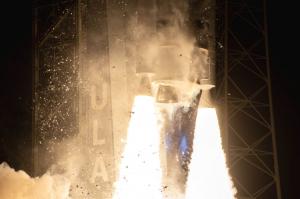NATIONAL SPACE SOCIETY APPLAUDS THE SUCCESS OF UNITED LAUNCH ALLIANCE’S NEW VULCAN ROCKET
New Booster Offers Competition and Dependability for U.S. Launch Requirements
The successful launch of the Vulcan marks a significant space development milestone.”
KENNEDY SPACE CENTER, FLORIDA, USA, January 10, 2024 /EINPresswire.com/ -- The new United Launch Alliance (ULA) Vulcan booster launched on its maiden journey at 2:18 a.m. Eastern Time on Monday, January 8. Besides being a certification flight, the new rocket carried a range of payloads, ranging from a suite of instruments provided by NASA to a variety of privately contracted items, 15 in all. The National Space Society (NSS) cheers this important milestone.— Dale Skran, NSS COO/SVP
Shortly after launch, NASA Administrator Bill Nelson said, “The first CLPS launch has sent payloads on their way to the Moon,” noting that the Commercial Lunar Payload Services (CLPS) program, under which NASA hires launch, lunar landing, and other services from commercial suppliers, will support not just science, but also the growing commercial space economy. “We have so much science to learn through CLPS missions that will help us better understand the evolution of our solar system and shape the future of human exploration for the Artemis Generation,” he added.
The flight was also the first use of newly designed BE4 rocket engines from Jeff Bezos’ Blue Origin. In a unique case of "coopetition," Blue Origin (BO)—which will ultimately compete with ULA for launches—agreed to provide ULA with BO’s own high-output rocket engines when ULA’s previous powerplant, the Russian-manufactured RD-180, became unavailable after the invasion of Ukraine. The new engines performed flawlessly during the flight and are the U.S. use of liquid methane as a propellant to reach orbit and beyond —an important step to engine reusability. While this launch was flown in expendable mode, ULA does plan to complete development of partial reusability for the Vulcan in the future.
“The successful launch of the Vulcan marks a significant space development milestone,” said Dale Skran, NSS COO/SVP. “As the first U.S. company to use methane-liquid oxygen engines to reach orbit and beyond, ULA has proved a technology that has the potential to support more reusable rocket engines than those fueled by kerosene or hydrogen. Although China was first to reach orbit with methane-lox technology in 2023, the Vulcan carries a far larger payload and has much greater economic significance.”
The primary payload for the flight was the Peregrine robotic lunar lander, built by Astrobotic Technology out of Pittsburgh. The lander was a direct result of the CLPS program and represents an important step in realizing the benefits of public-private partnerships to reduce the cost of space exploration and development. It carried a variety of payloads from various governments and private entities with the intention of delivering them to the lunar surface, which would have represented the first U.S. landing there since Apollo 17 in 1972.
The Peregrine lander was sent into a lunar trajectory soon after the Vulcan reached orbit but soon began experiencing anomalies that included loss of propellant needed for its landing engines. Astrobotic engineers have confirmed that a controlled lunar landing is now impossible.
“Space frequently reminds us how hard it can be,” said Hoyt Davidson, the NSS Executive Vice President. “Failures and setbacks such as this are to be expected and it is clear that Astrobotic’s engineers are gaining valuable insights for future missions and pushing the still active Peregrine spacecraft to complete as much science as is feasible.”
While SpaceX has had notable success with its Falcon 9 rocket, lofting over 90 percent of the U.S.’s 109 orbital launches in 2023, the NSS believes that robust competition is critical to driving the level of sustained innovation needed for the new space age. The Vulcan not only provides competition for domestic launch providers, but also allows ULA to be an alternative provider for mission-critical launches should the need arise.
Karlton Johnson, the Chairman of the NSS Board of Governors and Colonel, U.S. Air Force (ret), added, “The success of Vulcan provides vital redundancy for U.S. National Security launches. The NSS strongly supports a robust launch industry with multiple competing options.”
While the landing of commercial payloads on the Moon by the Peregrine lander will not occur, other commercial payloads were successfully delivered into space by the Vulcan. “I’m so proud of this team,” said ULA President and CEO Tory Bruno. “This has been years of hard work.” ULA noted that they may be ready to launch another Vulcan as early as April 2024. ULA is a partnership between aerospace giants Boeing and Lockheed Martin.
Noteworthy among the payloads successfully lofted were a variety of “cremains,” the ashes of prominent individuals, that included important figures from "Star Trek," as well as Mark Hopkins, a recently passed leader of the National Space Society. These remains, which were separate from another memorial payload on the ill-fated Peregrine lander, will fly past the Moon and eventually into deep space.
ABOUT THE NATIONAL SPACE SOCIETY
The National Space Society was founded in 1987 via a merger of the National Space Institute and the L5 Society. The NSS is the preeminent citizen's voice on space exploration, development, and settlement. To learn more about the NSS and its mission to establish humanity as a spacefaring species, visit us on the web at space.nss.org.
Rod Pyle
National Space Society
+1 626-399-4440
email us here
Visit us on social media:
Facebook
Twitter
LinkedIn
Instagram
YouTube
Legal Disclaimer:
EIN Presswire provides this news content "as is" without warranty of any kind. We do not accept any responsibility or liability for the accuracy, content, images, videos, licenses, completeness, legality, or reliability of the information contained in this article. If you have any complaints or copyright issues related to this article, kindly contact the author above.

